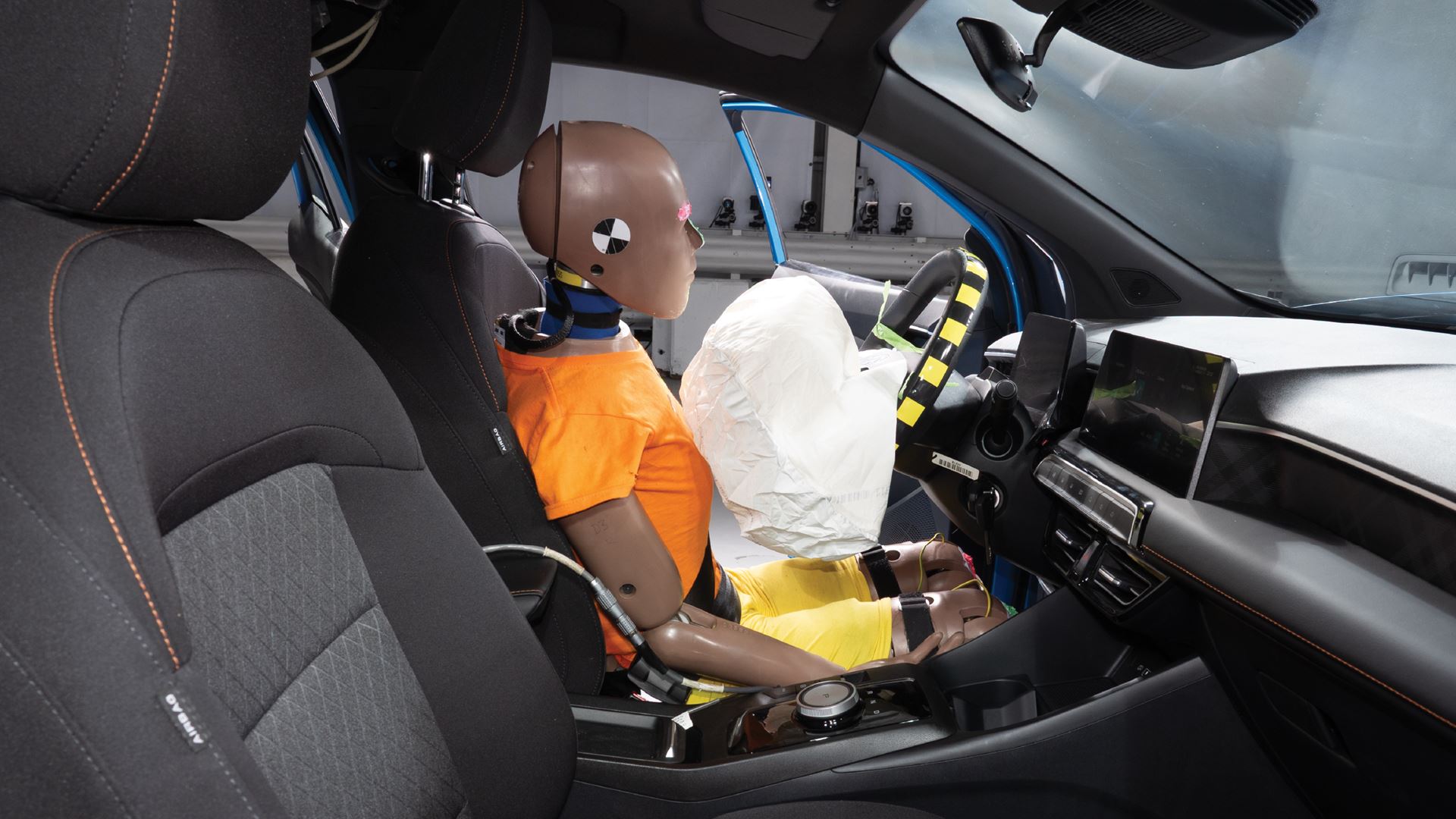LEUVEN, BELGIUM – For decades, MG’s catchy slogan was ‘Safety Fast’ as the British marque traded on sporty cars that took good care of drivers. However, during Euro NCAP testing, the latest MG 3 from the now-Chinese-owned company suffered a critical safety failure.
During the frontal offset crash test, Euro NCAP’s engineers found that the driver’s seat latching mechanism failed. Such a seat adjuster failure has not been seen before in Euro NCAP testing, which has assessed hundreds of passenger vehicles since it began work in 1997.
The failure of the latching mechanism caused the driver’s seat to twist partway through the impact. This movement led to elevated forces on the dummy’s right leg, with protection for that body region assessed as ‘poor’. The seat failure also meant that MG could not demonstrate how well the car would protect the knees and femurs of occupants of different sizes or those seated in varying positions.
Euro NCAP shared its findings with MG, which initially argued that the failure was due to improper latching of the seat before the test. However, as is standard procedure, the seat’s latching had been checked before testing was conducted. MG has subsequently committed to improving the design of the seat latch mechanism to ensure it remains robust in the event of an impact.
Despite the seriousness of the issue, which raises questions about how well the 3 can protect its driver in the event of an impact, Euro NCAP’s scoring system does not currently allow for a deduction or override in the case of such a component failure. As a result, the MG 3 still qualifies for four stars, thanks to its performance in other areas. These include crash-avoidance, which was recently improved on the 3 after the company added more driver-assistance systems, following a disappointing three-star rating by sister organisation, ANCAP, last year.
Aled Williams, Programme Director at Euro NCAP, says the organisation recommends that consumers consider other cars over the MG 3.
Euro NCAP conducts independent safety testing of new cars so that consumers can be fully informed about how well a model is likely to protect them on the road. It is troubling to find a car on sale in 2025 with a fundamental weakness in its seat latching mechanism, an essential part of the car’s occupant restraint system. This fault has been reported to the relevant Type-Approval authorities so consideration can be given as to whether a vehicle recall should be issued. For that reason, we would recommend that consumers consider alternatives to the MG 3, using the search tool on our website to pick the safest cars that meet their needs.
— Dr. Aled Williams, Programme Director Euro NCAP
A small hybrid hatchback with family appeal
MG, once a British marque, is now wholly owned by SAIC Motor Corporation, the largest of the “Big Four” state-owned Chinese car manufacturers. Since its relaunch in Europe, MG has positioned itself as a value-focused alternative to established Japanese and European brands, combining low prices with long warranties and high equipment levels.
The 2025 Model Year MG 3 represents the latest iteration of the MG 3 line – a popular small car that has appealed to drivers looking for affordable, fuel-efficient, and practical transport. Eschewing the trend towards full-electric, it is available as a hybrid and non-hybrid petrol and appeals to budget-conscious buyers who may be looking to reduce their emissions without switching to a fully electric vehicle.
Positioned against rivals like the Renault Clio and Toyota Yaris, the Hybrid version combines a petrol engine with an electric motor and battery, allowing for limited zero-emissions operation at low speeds. The vehicle is part of MG’s broader push to grow market share in Europe, where its sales have increased significantly in recent years due to competitive pricing and generous equipment levels.
However, Euro NCAP’s findings may prompt further scrutiny from consumers and safety advocates.
Compromised crash performance
In the frontal offset test – one of the most demanding in Euro NCAP’s programme – the MG 3’s passenger cell remained structurally stable. However, the seat failure compromised the restraint of the driver dummy, leading to twisting of the seat mid-impact, and significantly worsening lower leg injury metrics.
In addition to the seat mechanism failure, the driver dummy's head was found to ‘bottom out’ the airbag, contacting the steering wheel. As a result, head protection was downgraded to ‘adequate’.
These results highlight how seemingly minor component failures can have a significant multiplier effect on injury risk, particularly in small vehicles where occupant space and energy absorption margins are more limited.
Following Euro NCAP’s findings, MG says it will implement changes to the driver’s seat latching mechanism from August and the driver’s airbag from October. However, these changes will not be performed on vehicles already in the hands of customers.
Euro NCAP will assess the effectiveness of these changes once made available and has shared its findings with the Vehicle Type Approval office that certified the MG 3 for sale across the EU, in case it believes a recall is required.
Dr. Michiel van Ratingen, Secretary General of Euro NCAP, says:
China’s car industry has undergone a rapid rise, with an influx of new brands and new models, and the nation became the world’s largest car exporter in 2023, overtaking Germany and Japan. Many of those new cars are being sold across European markets. That creates more choices for consumers, but on the other hand, they need to know that any car they are thinking of buying is safe. We would urge all car makers to ensure they adhere to rigorous development and production processes, so that they maintain the safety standards that are prevalent in Europe.
Euro NCAP’s protocols under review
While Euro NCAP’s current assessment protocols are designed to reward consistent, all-round protection, this case illustrates a rare gap in the scoring framework. Despite the highly unusual failure of a critical safety component, the car’s relatively strong performance in other areas allowed it to retain a four-star overall rating.
Euro NCAP will review this aspect of its protocols, particularly considering manufacturers choosing not to rectify or improve failed safety elements.
This is an almost unheard-of occurrence, but one that Euro NCAP will address through changes to our protocols and scoring so we can reflect any failure – even if the car’s overall performance is good – in our ratings. Our role is to help make roads safer for all, and we will continue to strive for the improvement of vehicle safety to help achieve this goal.
— Dr. Aled Williams, Programme Director Euro NCAP
Transparency and trust
Euro NCAP publishes its test results to support consumers in making informed, safe vehicle choices. In doing so, the organisation also encourages car manufacturers to make design decisions that prioritise the safety of drivers, passengers, and other road users.
This case serves as a reminder of the importance of rigorous testing – and the need for manufacturers to respond proactively to weaknesses revealed through independent assessment.

